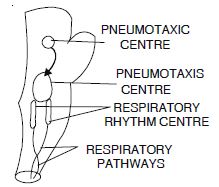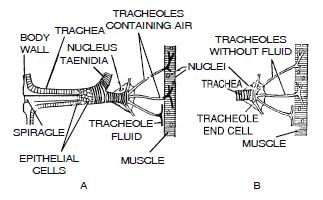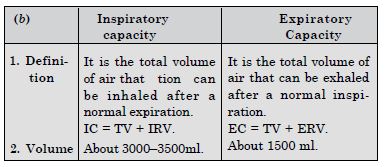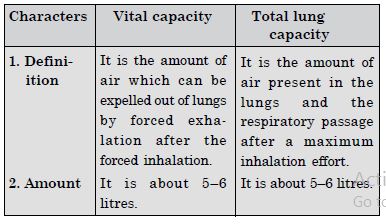Get access to free NCERT Solutions at Aasoka designed for students of Class 11. These solutions make it effective and efficient for students to grab the concepts related to the chapter. The subject matter experts who have designed the NCERT Solutions for Class 11 have written the content in an easy-to-understand language. The content in the solutions is as per the latest CBSE syllabus. Students can start their preparation with the solutions at Aasoka to score good grades in their exams.
The chapter “Breathing and Exchange of Gases” of Class 11 Biology covers topics like the concept of breathing, respiratory volume, movement and exchange of gases, disorders related to respiration, exchange of gases, regulation of respiration, transport of gases, breathing regulation in humans, etc.
Question 1:
Define vital capacity. What is its significance ?
Answer:
Vital Capacity (VC) of Lung. It is the maximum amount of air that can be expelled from the lungs by forced exhalation after a forced inhalation. It is equal to sum of tidal volume, inspiratory reserve volume and expiratory reserve volume.
Vital capacity of lung = TV+ IRV + ERV
= 500+(2500 to 3000) + 1000 to 1100
= 4000 to 4600 ml
Range of vital capacity = 3.5 – 4.5 litres in a normal adult person.
The vital capacity is higher in athletes, mountain dwellers, men and young.
Significance. The vital capacity is directly proportional to its capacity of increase during ventilation for gaseous exchange.
Thus, greater is the vital capacity, more is energy available to the body.
Question 2:
State the volume of air remaining in the lungs after a normal breathing.
Answer:
On an average 1100 ml to 1200 ml. of air remains in the lungs after a normal breathing and is called as residual capacity.
Question 3:
Diffusion of gases occurs in the alveolar region only and not in the other parts of the respiratory system. Why ?
Answer:
For diffusion to occur, it is essential that there exists a partial pressure difference of oxygen and carbon-di-oxide which is nil in other parts of respiratory system. Also, the alveolar walls are very thin , moist, richly supplied with blood capillaries which aid diffusion as compared to other parts.
Question 4:
What are the major transport mechanisms for CO2 ? Explain.
Answer:
- About 7% of CO2 is transported in dissolved state in plasma of blood.
- About 70% of CO2 produced enters R.B.C. by diffusion. Each decilitre (100 ml) of blood receives 3.7 ml of CO2 from tissue and rest of CO2 diffuse into blood plasma to form carbonic acid with water.
This reaction occurs in the presence of an enzyme called carbonic anhydrase.
Bicarbonate ions pass out from erythrocytes. - About 23% of CO2 is transported by haemoglobin.
Question 5:
What will be the PO2 & PCO2 in the expired air compared to those in the alveolar air?
- PO2 lesser, PCO2 higher
- PO2 higher, PCO2 lesser.
- PO2 higher, PCO2 higher.
- PO2 lesser, PCO2 lesser.
Answer:
(ii) PO2 higher and PCO2 lesser.
Question 6:
Explain the process of inspiration under normal conditions.
Answer:
During inspiration, the size of the thoracic cavity gets increased in all dimensions. The peripheral muscles of the diaphragm contract making the diaphragm flat. This increases the volume of the thoracic cavity in antero-posterior direction. The external intercostal muscles called inspiratory muscles of the ribs contract thus raising the sternal ends of the ribs. The ribs are extended anteriorly as well as laterally and the sternum is pushed below. This increases the volume of the thoracic cavity dorsoventrally and laterally. The increased area of the thoracic cavity decreases the pressure in the pleural cavities and the lungs expand. This decreases the intrapulmonary pressure below the atmospheric pressure, therefore, atmospheric air, with more pressure rushes into the lungs through respiratory passage. This stage of respiration is known as inspiration or inhalation.
Question 7:
How is respiration regulated ?
Answer:
(1) Neural Regulation
(a) Respiratory Rhythm Centre. It is present in medulla region of the brain and regulates the basic rhythmicity of respiration.
(b) Pneunotaxic Centre. It is located in the pons region of the brain and moderates the function of the respiratory rhythm centre.
(2) Chemical Regulation. Chemore-ceptors present in carotid and aortic bodies can recognise changes in CO2 and H+ concentration and send necessary signals to the rhythm centre for remedial actions.
Question 8:
What is the effect of PCO2 on Oxygen transport ?
Answer:
An increase in value of PCO2 decreases the affinity of haemoglobin for oxygen and increases release of oxygen to the tissues. This causes the shifting of the oxygen haemoglobin dissociation curve towards right. This effect is called the Bohr’s effect.
Question 9:
What happens to the respiratory process in a man going up a hill ?
Answer:
The respiratory rate in a man going up a hill increases from the normal value of 12-14 times per minute to 25-28 times per minute. The physiological demand of the body for oxygen rises and the vital capacity of lungs also increases.
Question 10:
What is the respiratory mechanism in an insect ?
Answer:
The respiratory organs are air tubes or tracheae. They form a network in the body cavity.
Trachea communicate with the outside by ten pairs of stigmata or spiracles. Out of these two are thoracic and rest are abdominal. The stigmata of the Ist thoracic and Ist abdominal pair always remain
open whereas the remaining stigmata close and open only during inspiration. The stigmata bear bristles which prevent the dust particles from entering the body.
Each stigmata opens into a small tracheal chamber or atrium, from which arise tracheal trunks. From these trunks arise large tracheae which branch and rebranch forming a network. Their ultimate branches are called tracheoles which penetrate all the parts of the body and end in tissue cells.
Question 11:
Define oxygen-dissociation curve. Can you suggest any probable reason for its sigmoidal pattern ?
Answer:
The relationship between the partial pressure of O2(PO2) and percentage saturation of the haemoglobin with oxygen is graphically represented in the form of oxygen dissociation curve. The curve shows that there is a progressive increase in the percent saturation of haemoglobin with increase in PO2 upto a level and there after it becomes constant. So a normal oxygen dissociation curve is sigmoid.
Question 12:
Have you heard about hypoxia ? Try to gather information about it and discuss with your friends.
Answer:
Hypoxia is a condition of oxygen shortage in the tissues.
It is two types :
Artificial hypoxia. It results from shortage of air as at high altitude. It causes mountain sickness.
Anaemic hypoxia. It results from the reduced oxygen carrying capacity of the blood due to anaemia.
Question 13:
Distinguish between:
- IRV and ERV
- Inspiratory capacity and expiratory capacity.
- Vital capacity and Total lung capacity.
Answer:
(c) Differences between vital capacity and total lung capacity
Question 14:
What is Tidal Volume ? Find out the tidal volume for a healthy human in an hour time.
Answer:
The volume of air inspired or expired with each normal breath is called tidal volume. Its volume is 500 ml.
Normal respiratory rate = 12 times/minute = 720 times/hour So, tidal volume in an hour time
= 720 × 500
= 360 litres/hour.





